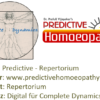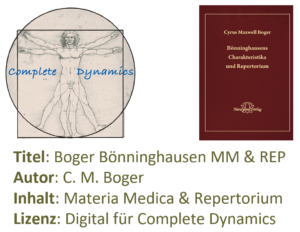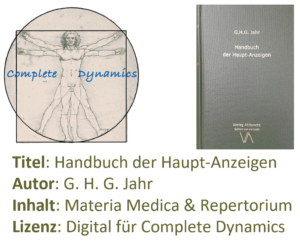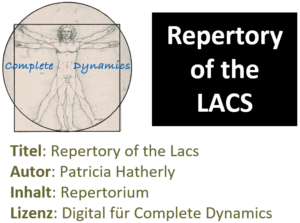Zusatzlizenz REP: Q-Rep repertory (Jeremy Sherr)
€90.00
Titel: Q – Rep
Autor: Jeremy Sherr
Inhalt: Repertorium
Lizenz: Digital für Complete Dynamics
Lizenzlaufzeiten: Dauerlizenz
Upgrades Repertoriumslizenz: kostenlos
Support: kostenlos
Description
Titel: Q – Rep
Autor: Jeremy Sherr
Inhalt: Repertorium
Lizenz: Digital für Complete Dynamics
The following introductory text about Q-Rep, the Repertory of Mental Qualities, has been provided by the author, Jeremy Sherr.
Introduction to the Repertory of Mental Qualities [Q-Rep]
Welcome to the Repertory of Mental Qualities [Q-Rep], compiled by Jeremy Sherr and Raphael Neu
I can absolutely guarantee that using the Q-rep properly will lead to better results and more accurate use of small remedies in your practice. This is our clinical experience, and the feedback we are getting from many users.
To get the best out of your Q-Rep I recommend reading this manual and watching our short demo movie on our Website.
Every repertory has a different philosophy and it should be used accordingly. The following is a discussion of the concepts behind the Q-Rep, the method of its creation and instructions on using it
What led me to develop this repertory
How often have you seen a case where it was clear that too much caring about others was a major issue? Have you had difficulties finding the most appropriate rubric to represent this idea? I certainly have. Should I use “Cares, full of, others about”, “Sympathetic” or perhaps “Anxiety others, for”? There are literally hundreds of rubrics that might be appropriate, and there is no way anyone can know them all.
How often do we see a case where the patient presents a variety of issues related to money, resulting in a dilemma if to use “Fear of poverty”, “Avarice”, “Ambition, increased money to make” “Extravagance” etc. Again, there are hundreds of rubrics relating to money issues.
How many times have you tried to repertorise low self esteem, victim, obsessive compulsive disorder or sensitivity to opinion of others, but found that the rubrics are too small, inappropriate or just not there. Which rubric do you use when your patient feels trapped or feels divided? Our patients have major issues which just do not always represent well in the conventional repertories or are fragmented into a many smaller rubrics.
I remember many cases where the patient had many snake issues. I had to combine “Fear of snakes”, “Dreams of snakes”, “Delusion of snakes”, then added a materia medica word search for the word “snakes”, and still wished I could easily add all the snake remedies to my combined rubric. Occasionally I wanted plant remedies that relate to snakes names [e.g Cereus serpentinus]. It was repetitive work that took up a lot of my time.
Finally, are you getting to use the hundreds of new provings that come out every year, provings that do not yet appear in the Materia Medica or repertories? The Q-Rep has the very latest homoeopathic data.
I decided to compile a new repertory that would address all these issues, a repertory that would save time and be simple to use. A repertory that will increase your chances o finding the right remedy. The Q-Rep is an easy solution to all the problems listed above, and it delivers much more.
KIS
In these days homoeopathy abounds with many new remedies, complicated methodologies and huge repertories. These may all be very useful, but I believe that good homoeopathy often works on the KIS principle- Keep it simple. Let me give an example.
My definition of the right rubric is ‘The rubric that has the right remedy in it’. This might seem obvious, but none the less it is true. Holding this guideline in mind has helped my students when choosing rubrics. If all the rubrics we use in the case have the right remedy in them, then this remedy MUST come out in the final result. Bearing this in mind, it is easy to understand why larger and more inclusive rubrics are more likely to lead you to the right remedy.
There are too many uncertainties in choosing rubrics to take any unnecessary chances. Every slight mistake could lead to the loss of the remedy, especially in the case of smaller remedies. In consequence, I much prefer to have more remedies in the end result of my repertory work, but to be sure the right remedy is there. I can then go through the final repertory result, remedy by remedy, and choose the most appropriate one according to the totality of symptoms and my perception of the case.
The Q-Rep provides rubrics which are simple to choose but are all inclusive. If your patient definitely has the issue you have chosen it is almost certain that the Q-Rep rubric will have the right remedy in it. This makes for simple and effective homoeopathy
You may be familiar with my statement “The Mind is a mine field”. There is much room for mistakes in understanding the patient’s mental issues and even more room for mistake when choosing mental rubrics. There is no point using a fancy delusion or keynote that looks good but does not include the right remedy in it. Rather than selecting a small rubric and risking not having the remedy in it, it is much better to spend a bit more time looking at a longer list of remedies, comparing them carefully to your understanding of the case and particular symptoms, till you feel happy with your choice. Using Q-rep will allow you to take a big short cut to that list of remedies.
In my daily work I favour the Boenninghausen approach to repertorisation, using bigger generalized rubrics, where I am as certain as possible that the right remedy is included. After this I choose the best remedy according to the essential features of the case and the particular symptoms.
This method is particularly useful for both one sided cases-as have seen time and again in my work in Africa-, and for over complicated cases where there is TMI – Too much information-.
Qualities
I call my repertory the Repertory of Mental Qualities, for four reasons
1. Quality means individual characteristics of a person.
2. When choosing the degree of the remedy, I have emphasized the quality of information, as opposed to repertories based on Kent’s repertory, in which the degree is based on the frequency of the symptom. In my repertory I have focused on the quality of the symptom for each remedy and the quality of the source of information to decide on the degree I give it in Q-Rep. For example, while Lac-f appear in the first degree in “Fear of sharp things”, in the Q- Rep I give it four points as it is a prominent feature of the remedy, although from only one prover.
3. I have put a strong emphasis on quality and accuracy throughout this work.
4. This repertory should lead to an improvement in the quality of your results!
Simplify your case work
Avoid needing to combine rubrics and worrying you missed one
Be sure the most accurate remedy is in your repertory results
Increase your use and knowledge of small remedies
Have access to the very latest proving
Creating the Qualities
The idea of the Q-Rep is to create all-inclusive rubrics of major mental themes which have a very high [95% and up] chance of having the right remedy in them. This is based on the Boenninghausen concept of generalisation, and also on the concept of affinities. For instance, if a case has definite issues of “victim” and “home”, and the main physical affinity is bones, we can use these three qualities to repertorise [taking bones from the generals]. There is a very high probability that the right remedy would be in the end result. This system is simple to use, as we do not have to choose a precise small rubrics which may not have the right remedy included.
I started by creating a list of Mental Qualities that came up frequently in my day to day practice. As well as the themes of caring, money, self-esteem, victim, obsessive-compulsiveness and snakes, I chose Qualities such as perfectionist, control, divided, guilt, clairvoyance, failure, embarrassment, opinion of others, knives and points, home, water, music, spiders, trapped, insects, spiders, big ego etc.
The Q-Rep is much more than a simple compilation of rubrics and materia medica searches. Materia Medica searches are very useful, but can often lead to mistakes. For instance, if we search for the word “fall” for the the quality of “High and low”, we may get the rubric “Coma with falling of eyelids”, which is not appropriate. A search for the word Embarrassment will yield remedies mentioned as “NOT being embarrassed” or remedies listed under “Unlike Bar-c, embarrassment is not an issue in this remedy.” In a similar way, searches for the theme of “dark” will bring up remedies with “dark thoughts” or “dark urine”. A search for “perfectionist” might bring up many remedies from cases, but often this symptom was not cured, and therefore is not valid.
Other inaccuracies came from some modern materia medicas, which tend to be relaxed when adding remedies from families or collective themes. For instance, Cuprum-metallicum may have Obsessive Compulsive Disorder, but while this may be true for some Cuprum salts, it is not necessarily true for all Cuprum salts.
To create a repertory that would be as accurate as possible we have personally checked and re-checked every entry at its source, be it proving, materia medica, clinical additions or cases.
Primary rubrics
I often use Phatak’s repertory, which is based on Boger’s repertory. In these repertories only the remedies which have the rubric’s theme as an essential part of their makeup are included. So for instance, in Phatak’s repertory the rubric “white discharges” contains only 20 remedies, far fewer then in Kent or Synthesis, but you know that the remedies included have white discharges as a major theme, such as Kali-mur. This is true even if the remedy is small.
Therefore I decided to create a “Primary rubric” alongside each Main rubric. This represents remedies which have the theme as a major issue, even if they are minor remedies. We should use these Primary rubrics only in cases where the issue is very intense, pronounced and is an essential feature of the case.
By including the opposite approach of Boenninghausen, which contains all possible remedies in the generalized rubrics, side by side with the Boger-Phatak approach of rubrics with only the most prominent remedies, I have attempted to create a repertory that will span both trends and so present more possibilities of use.
The Primary rubric should be used only when the Mental Quality you want to repertorise is a major and essential characteristic of your patient’s morbid makeup.
How to get the best results using the Repertory of Mental Qualities
The Q-Rep is not a substitute to the existing repertories, but a compliment to them. To get the best results from this repertory, I suggest that you use a few qualities that are essential and major theme of the case. You can use one or more of the Mental Qualities in conjunction with rubrics or affinities from other repertories.
Here are a few examples
“Money”, “Home” and “Lung inflammation of”, “Low self esteem”, “Water”, and “Headache pulsating”
Of course you can use these Mental Qualities rubrics in any sequence or combination you want, e.g. do a repertorisation from another repertory and then add one or more Mental Qualities. You will be amazed to see how, when using a few rubrics with 200 or 300 remedies each, the result quickly boils down to only 20-50 remedies which are then easy to chose from with a keynote or from your understanding of the case.
The old homoeopaths used to say- Minimum Rubrics of Maximum Quality!
The process of creating The Repertory Of Mental Qualities
I started the work of creating the repertory in the summer of 2004. Preciseness, accuracy and maintaining quality were my main goals while creating the Qualities. While most repertories are created by going through remedies and adding their symptoms to rubrics, in this work I proceeded from the rubrics in search of remedies. The remedies for each rubric were compiled independently by two or more experienced homeopaths who compared their results at each step. During the investigation for each Quality we searched through many new and old Materia Medicas and repertories, new and old provings and cases. I then personally verified all the remedies. Finally we check to see if remedies from the same family were appropriate, and I added remedies from my own clinical experience. Because there are relatively few rubrics in the Q-Rep, we are able to add new provings very quickly.
Selection of Mental Qualities
I have chosen Qualities which my colleagues and I frequently needed in practice, especially ones that were not well represented in the repertories. I have omitted Qualities that already appear in the repertories such as “fear” “religious” or “forsaken”
Defining the precise nature of each Quality was crucial, as it enabled us to make fine distinctions among the remedies in question. The definition serves both as a guideline for the criteria for selecting remedies and as a guideline for the use of the Quality by the homoeopath. For instance the definition of Victim is – One who is consistently being, or feels he is being, physically or emotionally attacked, pursued, harmed, swindled or taken advantage of, by circumstances or those around him. This is not just “poor me feeling”, but a sensation of physical or mental attack.
Please read each definition carefully, as it will play an essential part in your accurate use of this repertory. For achieving the best results it is crucial that your choice of rubric is definitely appropriate for both the case and the definition of the Quality.
Some of the Qualities are a combination of several ideas. For example Type-A is a combination of ambition, industriousness, busyness, business, hurriedness, irritability and more, but the combination is more than simply just the sum of these ideas- it is a certain “go-getter” type of person. These were by far the most difficult rubrics to create.
Another example is Obsessive Compulsive Disorder. The decision to include a remedy in this Quality was the combination of several factors. For instance OCD may have impulsivity in its nature, but if the impulse is to run it is not appropriate for this Quality. And while the rubric “Thoughts persistent” is important in OCD, it is only when it appears in combination with other factors such as a compulsive desire to clean or count, that I would include it in the rubric. A higher degree was given to remedies with a variety of different issues documented for the same remedy, such as counting, checking, cleaning and monomania.
The author of a remedy played a major part in how confident I was about including it in a Quality and the degree I gave it. I gave importance to information coming from celebrated and realiable authors and downgraded or eliminated remedies coming from speculative or unreliable sources [e.g. single cases with poor cures, attributing a symptom to a whole “family” without sufficient proof, speculative Materia medica etc]
Remedy degrees
There are four degrees for remedies
4th degree – Primary remedies – Remedies having this quality as a major and essential characteristic of their pathogenesis.
3rd degree – Experimental for Primary remedies – Remedies having the Quality as an important issue in their pathogenesis.
2nd degree – Remedies definitely belonging to this Mental Quality.
1st degreet – Experimental ? Remedies with which had only a minor symptom of this rubric, for instance a single dream in a new proving, and are not yet confirmed.
Primary rubrics-Contain only remedies with 3 and 4 points. When using the primary quality this should be an essential and major characteristic of the case.
Please be aware that these degrees are different from the Kentian degrees, as they relate to Quality rather than frequency!
The family groups
The -grp remedies [e.g. Carbon-grp or Gems-grp] represent families that are prominently related to the particular Quality. For example, Aur-grp. is in the “self esteem” Quality, meaning that it is possible that some of the other Aurum salt may have this characteristic.
Rather than including all the remedies in a family, which may not be accurate for each individual remedy, I allow the user to decide by looking at each of the remedies in that family. The fact that Kali-c is included in OCD does not necessarily mean that all Kali-salts have this Quality – that is a dangerous assumption. By creating the -grp. remedies I allow for the possibility of a salt having the symptom, until this is confirmed or denied by clinical experience.
I have made no assumptions about families. If Ars and Iod are present to a high degree in a Quality, it does not necessarily mean that Ars-iod is, unless there are other factors to support its inclusion. However if the Quality seemed to be present in a few of the Iod salts, I have added Iod-grp experimentally. This gives the user an opportunity to check all the salts and to confirm or deny their clinical usefulness.
Collaborating in updating this repertory
I hope to see this repertory continually updated and improved by collaboration with you, its user. Your clinical experience can contribute to improving the accuracy of remedies and their degrees.
I look forward to receiving your additions, suggestions and clinical experience for updating this repertory and improving it. When suggesting an addition please include the reasons for doing so.
I also welcome your suggestions for new Mental Qualities. Please include the reason and possible definition.
These suggestions can be e-mailed to Raphael Neu at raphael.neu@ntlworld.com.
New Provings
Most new provings added can be accessed or found through www.provings.com
Word of thanks
I want to take this opportunity to thank all those that made this project possible. First and foremost is Raphael Neu. Raphael is an Israeli homeopath now living in England. He has worked tirelessly alongside me during this whole project. I particularly appreciate his conscientiousness and preciseness. Without his help this repertory would not be possible. You can see Raphael on http//www.rafineuhomeopathy.com/contact.html Sandi Kaplan and the team at Dynamis Minnesota for their excellent contributions. Cynthia Moyano, Diane Brindley, Kelly Callahan and the team at Dynamis for most wonderful and precise work. Yael Kfir for checking new provings And thanks to all homeopaths who sent in their new provings and to all those who do not neglect to add their provings and clinical findings to the repertory.
Special thanks to Frederik Schroyens and Roger Van Zandvoort. I now appreciate how much work they have both put into the gigantic projects of creating their repertories.
To Tina Quirk for always being there.
To my wife Camilla, for her continued inspiration. She is the spark behind everything I do.
I sincerely hope that this repertory helps you, its user, to find the most suitable remedies for your patients.
Jeremy Sherr 2014
Only logged in customers who have purchased this product may leave a review.







Reviews
There are no reviews yet.